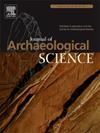Comparative study of Bronze Age ceramic moulds reveals diachronic and spatial change in mould material processing in the Central Plain of China, c. 13th-3rd century BCE
IF 2.6
1区 地球科学
Q1 ANTHROPOLOGY
引用次数: 0
Abstract
A combination of polarised light microscopy analyses with geochemical techniques interpreted through Principal Component Analyses (PCA) was employed to characterise ceramic bronze-casting moulds from China. Eighty-three ceramic bronze-casting moulds from five Bronze Age foundries, and seven soil samples from three of the five sites in the Central Plain of China were analysed, including Houma, the largest foundry site found to date in China. The results show two main differences in the body fabrics of these moulds: the presence/absence of calcite, and the mode of the quartz's particle size distribution, indicating a difference in the bronze-casting mould manufacturing techniques employed at each site.
This is the first time that a large number of Bronze Age moulds dated to different periods and from different regions were analysed by the complementary use of these two techniques, and the results indicate a diachronic and spatial change in mould material processing. This work will help understand bronze production in different regions of the Central Plain, and serve as a base to the establishment of a comprehensive database on ceramic bronze-casting moulds produced in different regions during the Chinese Bronze Age.
青铜时代陶瓷模具的对比研究揭示了公元前13世纪至公元前3世纪中原地区模具材料加工的历时性和空间变化
结合偏光显微镜分析和地球化学技术,通过主成分分析(PCA)来解释来自中国的陶瓷青铜铸造模具。研究人员分析了来自5个青铜时代铸造厂的83个陶瓷青铜铸造模具,以及来自中国中部平原5个遗址中的3个的7个土壤样本,其中包括中国迄今为止发现的最大的铸造遗址侯马。结果显示,这些模具的主体结构存在两个主要差异:方解石的存在/不存在,以及石英的粒度分布模式,这表明每个地点使用的青铜铸造模具制造技术存在差异。这是第一次通过这两种技术的互补使用来分析大量不同时期和不同地区的青铜时代模具,结果表明模具材料加工的历时性和空间变化。这项工作将有助于了解中原不同地区的青铜器生产,并为建立中国青铜器时代不同地区生产的陶瓷青铜铸造模具的综合数据库奠定基础。
本文章由计算机程序翻译,如有差异,请以英文原文为准。
求助全文
约1分钟内获得全文
求助全文
来源期刊

Journal of Archaeological Science
地学-地球科学综合
CiteScore
6.10
自引率
7.10%
发文量
112
审稿时长
49 days
期刊介绍:
The Journal of Archaeological Science is aimed at archaeologists and scientists with particular interests in advancing the development and application of scientific techniques and methodologies to all areas of archaeology. This established monthly journal publishes focus articles, original research papers and major review articles, of wide archaeological significance. The journal provides an international forum for archaeologists and scientists from widely different scientific backgrounds who share a common interest in developing and applying scientific methods to inform major debates through improving the quality and reliability of scientific information derived from archaeological research.
 求助内容:
求助内容: 应助结果提醒方式:
应助结果提醒方式:


